Olive-sided Flycatcher
(Contopus cooperi)
Conservation • Description • Habitat • Ecology • Distribution • Taxonomy
|
|
||||||||||||||
Description |
Olive-sided Flycatcher is a medium-sized tyrant flycatcher (family Tyrannidae) but a large “flycatcher” as that common name is applied. Only Great-crested flycatcher is larger. Adults have a tapered body, are 7″ to 8″ in length, and have a wingspan of 13″. The upper parts are olive-gray to olive-brown. The center of the breast is white and contrasts sharply with dark, olive-gray, streaked or mottled sides, giving the appearance of a dark “vest”. The belly is whitish. The undertail coverts are whitish with well-defined, dark, V-shaped markings. The wings are pointed and have indistinct pale wing bars. The tail is proportionately short. There is a white patch above each wing on the side of the rump but this is not usually visible when perched. The head is large and dark. The chin and throat are white. The eye ring is inconspicuous. |
Size |
7″ to 8″ in length 13″ wingspan |
Voice |
|
|
The song is one short note followed quickly by two longer longer notes, the middle note higher pitched: “quick, THREE beers!” The call is three quick notes: “pip pip pip.” |
Similar Species |
| Eastern Wood-peewee (Contopus virens) is smaller. The breast and sides are gray with no dark “vest”. There are no white patches on the rump. The markings on the undertail coverts are smudged. The wings have white, narrow but conspicuous wing bars. |
Habitat |
Breeding: Coniferous forest edges and openings, semi-open coniferous forests near water, burned areas, wetlands. |
Ecology |
Migration |
Early May to Mid June and early August to late September. They migrate alone, not in flocks. Olive-sided Flycatcher has the longest migration of any North American flycatcher. Breeding grounds are the Rocky and Cascade Mountains from Texas to Alaska, across Canada and the northern border states to Newfoundland and Vermont. In Minnesota the breeding range includes the northeast third of the state. Wintering grounds are mostly Panama and the northern Andes Mountains from northern Venezuela to western Bolivia. |
Nesting |
The nest is an open cup constructed on a high horizontal branch of a conifer tree well away from the trunk. It is made of twigs, grasses, and sometimes beard lichens, bound together with spider silk, and lined with finer plant materials. The female lays 3 or 4 eggs in June or July. The eggs are white, buff, or pink, and are spotted with brown or gray blotches at the large end. They hatch in 14 to 19 days. Both parents feed the young. The young leave the nest in 15 to 23 days |
Behavior |
Olive-sided Flycatcher is the only North American flycatcher to feed exclusively on insects caught in flight. When feeding it perches at the top of a tree or on a dead branch, launching occasionally to catch a flying insect in the air, and returning often to the same perch. Small insects are consumed in the air. Larger insects returned to and beaten against the perch to subdue. They defend their nests aggressively against squirrels and other predators. |
Food |
Flying insects, especially bees, wasps, and ants, but also moths, grasshoppers, dragonflies, and beetles. |
Distribution |
Occurrence |
Uncommon migrant and breeder |
Maps |
The Minnesota Ornithologists’ Union All Seasons Species Occurrence Map |
Taxonomy |
|
Class |
Aves (birds) |
Order |
Passeriformes (perching birds) |
Family |
Tyrannidae (tyrant flycatchers) |
Genus |
Contopus (peewees) |
|
|
Subordinate Taxa |
|
|
|
Synonyms |
|
Contopus borealis Nuttallornis borealis |
|
Visitor Photos |
||
Share your photo of this bird. |
||
This button not working for you? |
||
Kirk Nelson |
||
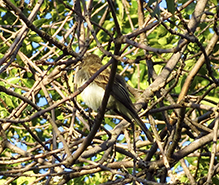 |
|
|
MinnesotaSeasons.com Photos |
||
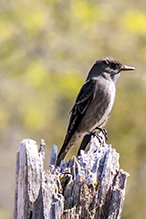 |
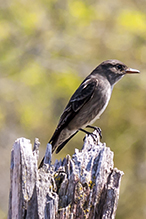 |
|
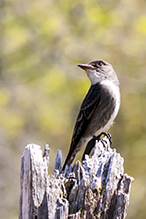 |

Slideshows |
Olive-sided Flycatcher |
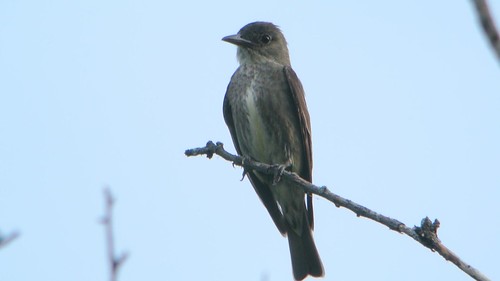
|
Olive-sided Flycatcher |
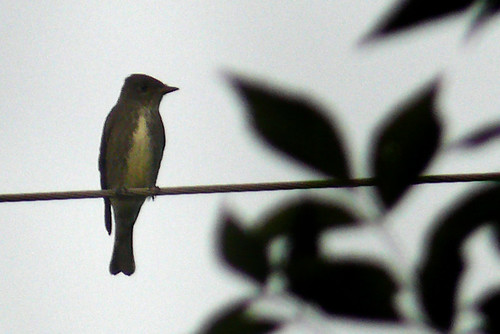
|

Visitor Videos |
||
Share your video of this bird. |
||
This button not working for you? |
||
|
Other Videos |
||
Olive-sided Flycatcher |
About
Uploaded on Aug 13, 2008 George Jameson sent us this olive-sided flycatcher video. |
Olive-sided Flycatcher |
About
Uploaded on Aug 13, 2008 George Jameson sent us this olive-sided flycatcher video. |
Olive-sided Flycatcher |
About
Published on Aug 11, 2012 Digiscoped at Tower Grove Park 8/11/12 |
Olive-sided Flycatcher |
About
Published on Jul 1, 2012 Olive-sided Flycatcher singing " Quick - Three - Beers " |
Olive-sided Flycatcher |
About
Published on Sep 29, 2014 take the highest perch |

Visitor Sightings |
||
Report a sighting of this bird. |
||
This button not working for you? |
||
| Kirk Nelson 8/14/2016 |
Location: Mississippi National River and Recreation Area, Coldwater Spring |
MinnesotaSeasons.com Sightings |
||

|
Created: Last Updated: © MinnesotaSeasons.com. All rights reserved. |
